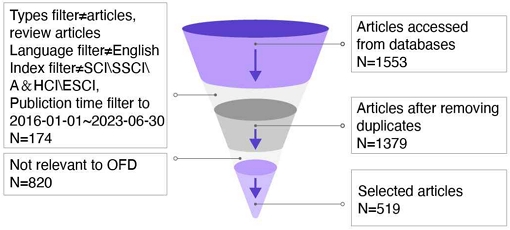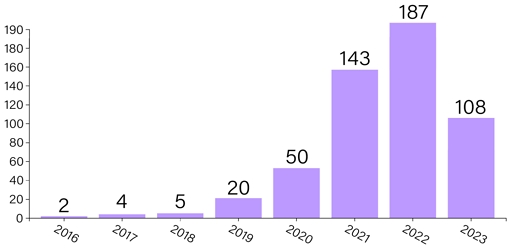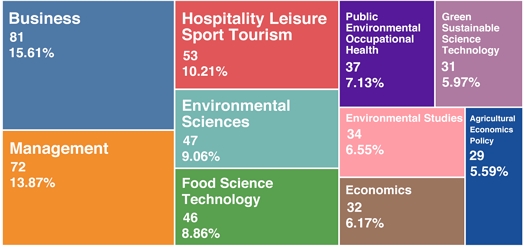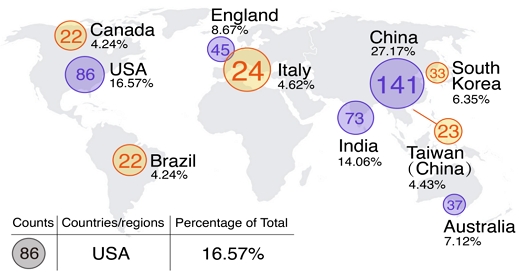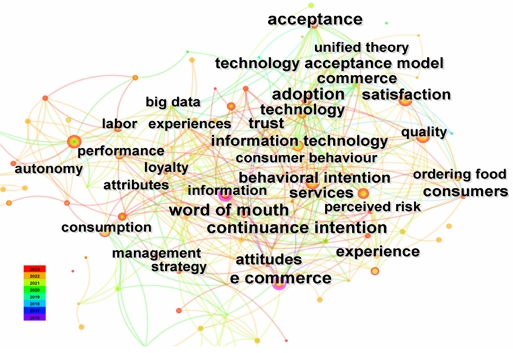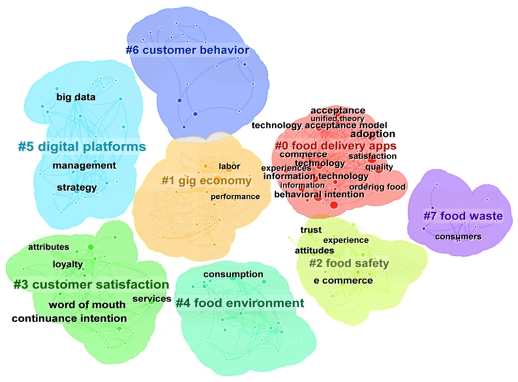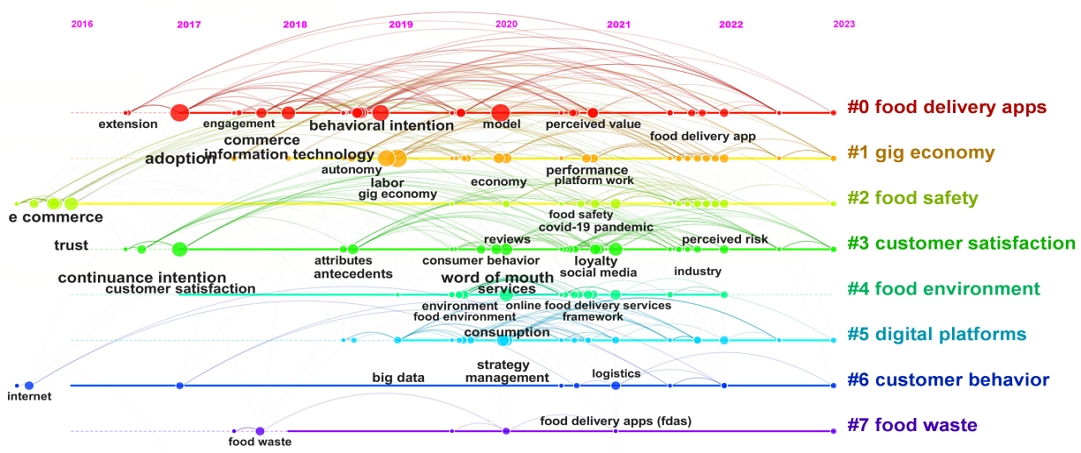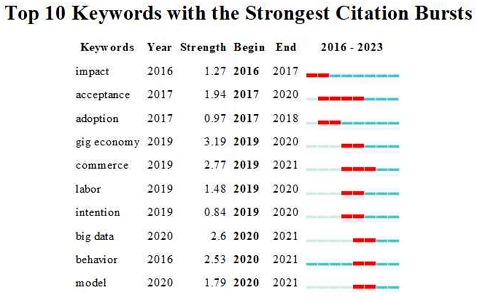
Bibliometric Analysis of Online Food Delivery Research Trends using CiteSpace
Copyright ⓒ 2023 The Digital Contents Society
This is an Open Access article distributed under the terms of the Creative Commons Attribution Non-CommercialLicense(http://creativecommons.org/licenses/by-nc/3.0/) which permits unrestricted non-commercial use, distribution, and reproduction in any medium, provided the original work is properly cited.

Abstract
Online food delivery (OFD) research involves various fields and disciplines, such as business, consumer studies, and social sciences. The OFD market has undergone significant changes from its inception to the COVID-19 era, and up to the present day. Accordingly, the focus of OFD research has changed remarkably in response to market dynamics and societal circumstances. However, due to a lack of comprehensive and quantitative analyses reflecting the research trends up to this point, these shifting patterns have yet to be discovered or captured. This study collected data from 519 relevant articles, published from 2016 to 2023 in the Web of Science database, and conducted scientific measurement and visualization analyses using CiteSpace. The analysis encompassed parameters such as the number of articles, journals, countries or regions, citation indices, and keyword analysis (timeline analysis, clustering analysis, and burst analysis). The analysis outcomes indicate that OFD research is still in its nascent stage, but progressing rapidly. Eight highly credible clusters were identified, proposing three research trends: customer experience, labor management, and sustainable development (including food safety) in OFD.
초록
온라인 음식 배달 (OFD)에 대한 연구는 경영, 소비자, 사회과학 등 다양한 학문 분야에 걸쳐있다. OFD 시장은 형성기부터 COVID-19 시기를 지나며 오늘에 이르기 까지 많은 변화를 겪었고, 이에 관련 연구에 있어서 시장 및 사회상황에 따라 연구의 초점도 다각적으로 변화되어왔다. 그러나 현재까지의 연구동향을 보여주는 종합적이며 과학적 계량 서지학적 분석이 부족하여 이 같은 변화의 양상을 파악하기 어렵다. 본 연구는 웹 오브 사이언스 (Web of Science) 데이터베이스에서 2016년부터 2023년까지 발행된 논문 중, 관련주제의 논문 519편을 수집하고 사이트스페이스 (CiteSpace)를 사용해 과학적 측정 및 시각화 분석을 수행했다. 이 분석에서는 논문 발행 수, 저널, 국가 또는 지역, 피인용지수, 핵심어분석 (타임라인분석, 군집분석, 버스트분석 등)을 다루었다. 분석 결과, OFD 연구는 아직 초기단계이나, 빠른 발전 단계에 있다는 것을 보여준다. 높은 신뢰수준의 8개 군집이 확인되었고, 이를 통해 고객 경험, 노동력과 관리, 식품 안전과 지속 가능한 발전이라는 세 개의 주요한 OFD 연구 동향이 도출되었다.
Keywords:
Online Food Delivery, Food Delivery Platform, Bibliometric Analysis, Visualization, CiteSpace키워드:
온라인 음식 배달, 음식 배달 플랫폼, 계량 서지학적 분석, 비주얼리제이션, 사이트스페이스Ⅰ. Introduction
The global outbreak of COVID-19 has brought about significant changes in people's lifestyles and consumption habits, with online food delivery (OFD) being one of the affected domains. In many countries, lockdown measures have made contactless OFD the sole means of connecting with the outside world for individuals isolated at home. Some restaurants have had to shift their operations towards OFD services creatively. OFD has witnessed substantial growth worldwide, with the global OFD market revenue reaching $248 billion in 2020, marking a 17% increase from pre-pandemic levels[1]. The pandemic has underscored OFD's impact on the market, and it can be anticipated that while the growth rate of the OFD market might moderate, it will continue to expand.
With the market's growth, OFD has gradually impacted the economy, environment, and society. OFD has opened up new sales channels for the deliverable food industry while posing a threat to traditional non-delivery food sectors and the hospitality industry. The proliferation of single-use meal containers and packaging bags associated with OFD has burdened the environment, leading to concerns among environmental advocates. The movement of delivery men within urban areas has implications for traffic and road safety, garnering attention from public discourse and the media.
Driven by market expansion and the resulting impacts, OFD has attracted academic attention, becoming a rapidly evolving interdisciplinary research field. Conventional review studies often need help distilling the development process from the vast literature, necessitating novel approaches to comprehensively survey and analyze the developmental characteristics and trends within this domain. With the advancement of information technology, bibliometric analysis software has proven valuable across various research fields, with CiteSpace emerging as the most widely used tool due to its comprehensive functionality. Over 30,000 scholarly works have employed CiteSpace for research, affirming its effectiveness.
In light of this, the objective of this study is to employ the bibliometric tool CiteSpace to review the literature concerning OFD. This review aims to ascertain publication trends, active content domains, and knowledge evolution and identify future research themes. The detailed procedure is as follows: Phase 1 involves the selection of relevant literature from the Web of Science. Phase 2 entails the analysis of publication years, journals, source countries or regions, and highly cited documents among the 519 selected articles. Phase 3 involves co-occurrence network analysis of keywords to identify high-frequency keywords. Phase 4 encompasses keyword co-occurrence cluster analysis to comprehend the nature and characteristics of significant clusters. Phase 5 entails keyword timeline analysis to understand the changes in keyword usage over time. Phase 6 involves burst detection of keywords to discover emerging trends and sudden shifts.
Ⅱ. Theoretical Background
2-1 Current State of Research in Online Food Delivery
Online food delivery (OFD) is a service wherein customers use mobile applications or websites to directly place orders for food from restaurants, and the delivery man subsequently delivers the food to the customers' specified locations[2]. Due to variations in scholarly interpretations, OFD is also referred to as on-demand food delivery (ODFD)[3], emphasizing the immediate delivery of food based on customer demand. Some scholars use terms like food delivery platform or food delivery app (FDA) to denote OFD and highlight the role of the platform.
OFD establishes an ecosystem consisting of platforms, customers, restaurants, and delivery man. The platform acts as an intermediary between customers and restaurants, collecting meal charges on behalf of customers, providing a wider range of food options, and expediting order processing. It charges commissions to restaurants, serving as a channel for the expansion of food businesses and the provision of higher-quality services[4]. The platform also acts as an intermediary between delivery man and customers, charging customers delivery fees and paying wages to delivery man. Delivery man are responsible for delivering food to customers, facilitating instant delivery. In this intricate system, the flow of both physical goods and information is involved.
So far, four review articles have provided in-depth discussions on the topic of OFD. LI[5] summarized 60 articles, focusing on the OFD in China and encompassing both Chinese and English articles. This study adopted a sustainable perspective, assessing the positive and negative impacts of OFD on society, the economy, and the environment. Arianna[3] conducted a systematic literature review (SLR) of 59 articles published from 2016 to 2022, categorizing stakeholders and ecosystem value-creating activities based on research methods and themes. Shankar[6] using SLR, reviewed 56 OFD related articles and synthesized the articles in terms of theory, background, methodology adopted, and analytical techniques used. However, none of the three review articles examined the temporal evolution of OFD.
Arvind[7] introduced bibliometrics into the field of OFD, summarizing 43 publications. The study employed SLR, bibliometric analysis, and thematic content analysis, utilizing the VOSviewer to emphasize six potential research topics, which were then consolidated into four knowledge clusters: (1) Digital intermediaries in OFD, (2) Dynamic operations in OFD, (3) Customer usage of OFD, and (4) Risks and trust issues in OFD. However, due to stringent criteria (e.g., focusing solely on business and management topics), a considerable number of relevant publications were excluded. While the reviews mentioned above have offered valuable insights into OFD literature, a more comprehensive review is indeed necessary.
2-2 Bibliometrics and CiteSpace
Bibliometrics is a branch of informatics that employs numerical and statistical methods to analyze knowledge domains and study emerging trends and knowledge structures within specific fields[8]. By providing quantitative methods, bibliometrics offers a novel approach to laying the foundation for driving field development and enabling scholars to obtain a comprehensive overview. To date, bibliometric analysis has been applied across diverse professional domains to provide panoramic representations, assisting interested scholars in pursuing targeted avenues for subsequent research.
The process of bibliometric analysis involves four steps. First, define the research objectives and scope, ensuring a sufficiently large scope to analyze a substantial number of articles, typically around 500 or more. Second, select bibliometric techniques. Typically, performance analysis components (e.g., total publications, total citations) should be chosen by default, and analysis and reporting should be conducted in both descriptive and analytical manners. Third, gather data for bibliometric analysis, deciding on multiple databases or a single one and determining appropriate terms for retrieval. Fourth, execute the bibliometric analysis and report the results, employing visual graphics to organize analytical discussions rather than purely descriptive discussions[9].
The use of bibliometrics in research has been growing in recent years, attributable to the expansion of scientific inquiry itself. However, applying classical review methods to a large volume of literature (e.g., hundreds or thousands) becomes cumbersome and impractical. The advent of scientific databases like Scopus and Web of Science has made obtaining substantial bibliometric data relatively easier. Various bibliometric softwares options have made literature analysis feasible, notably CiteSpace, VOSviewer, HistCite, Loet Leydesdorff, and Network WorkBench.
CiteSpace is a software designed for analyzing and visualizing co-citation networks. Developed by Dr. Chaomei Chen in 2004 using the Java programming language, its primary objective is facilitate the analysis of emerging trends within knowledge domains[10]. It is the most commonly used tool in bibliometric research and is particularly suitable for analyzing large volumes of literature. Through CiteSpace, it synthesizes the structure, patterns, and distribution of scientific knowledge, resulting in visual representations know as ‘mapping knowledge domains’. CiteSpace employs various units of measurement, including authors, journals, references, countries, institutions, keywords, funding, and publication time. The analysis within CiteSpace is categorized into four main sections: collaboration analysis (authors, institutions, countries), co-occurrence analysis (features, keywords, disciplines), co-citation analysis (references, authors, journals), and coupling analysis (references, funding).
Ⅲ. Methods
3-1 Data Collection and Processing
The representative dataset of literature in the OFD domain was constructed using the Web of Science Core Collection (WOSCC) database. WOSCC was chosen for its comprehensive coverage, encompassing 21,000 academic journals worldwide, with over 1.7 billion cited references and 159 million records spanning various fields, including natural sciences, engineering, biomedical, social sciences, arts, and humanities. Its widespread application in bibliometrics further supported our choice.
Given the lack of standardized terminology regarding OFD among scholars, a topic search strategy was employed as follows: TS="online food delivery" OR "food delivery app" OR "on-demand food delivery" OR "food delivery platform," resulting in 1553 literature entries. The earliest publications related to OFD were found in 2016, establishing the time span for this study from January 2016 to June 2023 (search conducted on July 13, 2023). The Document Types were restricted to "Articles" and "Review Articles," with the language filter set to "English". To ensure comprehensive and accurate retrieval, we limited the database sources to SCIE, SSCI, ESCI, and A&HCI, resulting in 1379 articles. A meticulous screening process was performed on the titles and abstracts of these 1379 articles, eliminating irrelevant literature related to OFD. Ultimately, 519 valid articles were identified for further investigation. Fig.1 shows the flow of data acquisition.
3-2 Data Analysis Method
This study conducted bibliometric analysis on the final set of retrieved literature using CiteSpace 6.2.R4 (64-bit) software. The basic statistical analysis encompasses publication years, publishing journals, source countries or regions, and highly cited articles. The visual analysis includes keyword co-occurrence network analysis, keyword co-occurrence cluster analysis, keyword timeline analysis, burst analysis of keywords, and keyword co-occurrence network analysis. Keyword co-occurrence network analysis represents the field’s development over time, illustrating the most significant tracks of related research activities. Keywords serve as nodes in the network, and co-occurrence phenomena are manifested through connections between nodes. Cluster view analysis categorizes the keyword co-occurrence network into multiple clusters, where keywords with similar characteristics are tightly connected within the same cluster, while loosely connected across different clusters. Timeline visualization analysis arranges the literature and keyword based on their publication dates or peak times [11]. Keyword bursts are indicators of the most active research areas and are used to detect sudden events, which can persist for many years. Keyword burst detection helps identify keywords that experience sudden spikes in citation frequency along the timeline.
Throughout all visual analyses using CiteSpace in this study, the parameter settings were kept consistent: k-value (k) = 5, slice length = 1 year, pruning = pathfinder, and other settings remained at their default values.
Ⅳ. Results
4-1 Basic Statistical Analysis
We analyzed the annual publication trend of existing literature on OFD, as shown in Fig. 2. Clearly, the number of publications exhibited an overall upward trend, rising from 2 articles in 2016 to 187 articles in 2022. This represents a nearly 100-fold increase over the span of 7 years, indicating growing attention from researchers towards OFD. Notably, there was a significant surge in publications after 2020. The emergence of new trends and abrupt changes in scientific literature may be attributed to internal and external factors, possibly related to the development of e-commerce and the outbreak of COVID-19. As of June 2023, 108 publications have been published in 2023, and more are expected in the future, with an estimated total surpassing 220 articles by the end of 2023.
The first literature related to OFD appeared in 2016 when Quevedo-Silva et al.[12] published the article titled "Intentions to purchase food through the internet: developing and testing a model" in the British Food Journal. In their study, the researchers utilized the Theory of Planned Behavior to assess customers' intentions to purchase food through the internet and proposed a more comprehensive model.
The analysis of published articles identified a total of 268 different journals related to OFD. Table 1 presents the top 10 journals with the highest number of published OFD articles. Notably, the British Food Journal ranks first with approximately 24 OFD articles. Regarding the journals' impact factors (IF), they range from 2.948 to 11.5. The International Journal of Hospitality Management stands out with the highest impact factor of 11.5.
Through the analysis of published articles, a total of 88 categories related to OFD were identified. Fig.3 presents the top 10 categories with the highest representation. The largest category is business, followed by management, hospitality leisure sport tourism, environmental sciences, and food science technology, among others. This indicates that research on OFD primarily revolves around the fields of business and management, gradually evolving into an interdisciplinary study with a high degree of integration.
The articles on OFD are geographically diverse, originating from 165 countries or regions. Fig. 4 presents the top 10 countries or regions in terms of the number of published OFD articles. Notably, 141 articles are from China, which can be attributed to its large population and leading position in the development of e-commerce. China holds the largest OFD market globally, sparking significant research interest in the field. Other countries with substantial literature, exceeding 30 articles each, include the United States, India, the United Kingdom, Australia, and South Korea. According to Statista[13], the countries with the highest OFD market revenue rankings were China, the United States, the United Kingdom, India, Germany, and France. Despite ranking relatively lower in the global OFD market, Australia and South Korea exhibit high research activity and interest in the field.
The articles has been ranked in descending order based on the number of citations, and Table 2 displays the top 10 highly cited articles. Among them, the articles by Yeo et al.[4] has received 106 citations. This article examined the structural relationships between convenience motivation, post-usefulness, hedonic motivation, price-saving orientation, time-saving orientation, prior online purchase experience, customer attitude, and behavioral intention towards OFD services.
4-2 Keyword Analysis
Keyword co-occurrence network analysis was conducted on the articles (Fig. 5), wherein the node type selected was keyword. The resulting co-occurrence network consisted of 299 nodes (merged network nodes) and 1491 links (N=299, E=1491, network density=0.0335). The colorful citation tree-rings depicted in the graph represent the nodes, with each node labeled by a specific keyword, indicating the number of articles in the OFD domain that utilized that particular keyword. The thickness of the citation tree-rings corresponds to the quantity of articles associated with the respective keywords; thicker rings indicate a higher number of occurrences. The colors within the citation tree-rings signify the publication time of the literature, with larger areas of a particular color representing a higher volume of articles published within that time interval. The colored connecting lines (links) between nodes represent the relationships between keywords. The interconnections among nodes signify their intricate relationships.
By examining the centrality (centrality>0.01) and frequency (frequency>15) of high-frequency keywords, we identified the top 10 most frequent keywords. Table 3 displays these 10 keywords along with their centrality values, frequencies, and the year of their first appearance. The most frequently occurring keyword is “satisfaction”, which appears 51 times and was first mentioned in 2020.
The Log-likelihood Ratio (LLR) algorithm was employed for keyword co-occurrence clustering analysis, resulting in the identification of 9 clusters. After removing an ineffective cluster, 8 clusters were retained (Fig. 6). The data indicated Modularity Q = 0.485, which falls within the acceptable range of 0.4 to 0.8, signifying that the network was divided into loosely coupled clusters. The mean silhouette value was calculated to be 0.6053, indicating that these clusters exhibit relatively good average homogeneity.
Each colored cluster represents a distinct group, and the 8 clusters, ranked from largest to smallest, are as follows: #0 online food delivery apps, #1 gig economy, #2 food safety, #3 customer satisfaction, #4 food environment, #5 digital platforms, #6 customer behavior, and #7 food waste. The high-frequency keywords within each cluster are depicted in black text.
Table 4 presents the size, silhouette value, average year of publication, and labels for the 8 identified clusters through Log-likelihood Ratio (LLR) algorithm-based keyword co-occurrence clustering analysis. The silhouette value indicates the homogeneity of the clusters, where silhouette>0.7 is considered to exhibit high homogeneity, and higher values indicate greater keyword consistency within the cluster.
(1) Cluster #0 food delivery apps, comprises 56 articles, with an average publication year of 2019. This cluster reflects research on topics such as customer technology acceptance, application quality, and customer value insights.
(2) Cluster #1 gig economy, includes 47 articles, with an average publication year of 2021. The gig economy refers to a labor market composed of freelancers and temporary workers who provide short-term or on-demand services to earn income. This cluster covers research on platform work, platform economy, algorithm management, and labor relations.
(3) Cluster #2 food safety, contains 37 articles, with an average publication year of 2020. Food safety pertains to ensuring food safety, reducing health risks, and preventing food poisoning during food processing, preservation, and sales. This cluster includes research on COVID-19 pandemic, loyalty, service advantage, trust, etc. After COVID-19, food obtained through OFD has become a potential source of transmission, making food safety a significant research topic.
(4) Cluster #3 customer satisfaction, consists of 37 articles, with an average publication year of 2020. Customer satisfaction refers to the percentage of customers whose experience with a company and its products or services exceeds a specified satisfaction goal. This cluster encompasses research on service quality, brand trust, and continuation intention.
(5) Cluster #4 food environment, comprises 32 articles, with an average publication year of 2020. Food environment refers to the physical presence of food that influences people's dietary behaviors, including the proximity to food stores, food store distribution, food services, and any physical entities that allow access to food. This cluster includes research on public health, green branding, microplastic pollution, etc.
(6) Cluster #5 digital platforms, include 28 articles, with an average publication year of 2020. This cluster covers research on collaborative consumption, Google maps, traffic conditions, etc.
(7) Cluster #6, customer behavior, consists of 21 articles, with an average publication year of 2018. Customer behavior refers to all activities related to the purchase, usage, and disposal of OFD services by individuals, groups, or organizations. This cluster includes research on influencing factors, application usability, various food choices, etc.
(8) Cluster #7 food waste, contains 12 articles, with an average publication year of 2017. Food waste refers to the amount of food that goes from residences, commercial establishments (restaurants), institutional sources, and industrial sources to landfills. This cluster encompasses research on health consciousness, food quality, user emotions, etc.
The timeline visualization provides a highly intuitive and accurate reference for understanding the evolutionary processes of various sub-domains. The timeline visualization depicts the clusters arranged along the top timeline axis from left to right. The main 8 clusters' timelines are shown in Fig. 7, with the top representing the timeline from 2016 to 2023, from left to right. Circular nodes represent highly cited keywords or keywords that triggered bursts of activity, and the labels of the keywords are placed below the circular nodes. The colored curves indicate the co-citation links added in the corresponding colored years. The clusters on the right are numbered in descending order, starting from 0, where cluster#0 is the largest cluster, followed by cluster#1 as the second largest cluster.
Horizontally observing Fig. 7, clusters #0, #1, and #3 exhibit highly concentrated burst nodes. Vertically observing Fig. 7, it can be observed that burst nodes appear in each cluster in the years 2020 and 2021.
According to the results of keyword burst detection, the top 10 keywords with the strongest bursts are arranged based on their appearance years (Fig. 8). These 10 keywords are: impact, acceptance, adoption, gig economy, commerce, labor, intention, big data, behavior, and model. The blue line represents the timeline, while the red line indicates the duration of the keyword bursts. A longer burst duration indicates a higher level of attention during a certain period. The keyword "acceptance" has the longest burst duration, starting in 2017 and ending in 2020. Notably, there were no burst keywords detected in the recent two years (2022-2023).
4-3 Research Trends
This trend encompasses three clusters: #0 online food delivery apps, #3 customer satisfaction, and #6 customer behavior. Researchers have extensively explored theoretical models to examine the factors influencing customers' willingness to adopt and continue using OFD services. These factors encompass trust, customer word-of-mouth, satisfaction, brand trust, loyalty, and service quality. Additionally, researchers have investigated how customer demographics, such as gender, age, or education level, moderate these factors.
The enhancement of customer experience in OFD has emerged as a central focus, encompassing efforts to improve the user interface, minimize waiting time, ensure food quality, and optimize pricing. Despite the significant growth of OFD, adoption rates remain relatively low in some countries, making it imperative to understand and promote the positive aspects of OFD to expand its market presence.
Furthermore, with the impact of COVID-19 gradually receding, it becomes essential to explore potential changes in customer usage intentions and behavior. Investigating how the decline of the pandemic affects customers' perceptions and preferences towards OFD services will be a pertinent area of investigation in future research.
This trend involves three clusters: #1 gig economy and #5 digital platforms. OFD work exemplifies the essence of platform work, setting it apart from traditional business models due to its creation of a two-sided market. Within the OFD system, value is generated by customers, platforms, restaurants, and delivery man concurrently. Delivery man, operating as freelancers, provide services to both customers and restaurants without formal employment by the platform. The algorithmic functions of OFD platforms have been subject to scrutiny for their potential exploitation of delivery man.
Despite these concerns, the role of the delivery man within the system cannot be underestimated, as any unavailability or irresponsibility on their part could result in losses for other stakeholders. Therefore, ensuring harmonious coexistence with all stakeholders is vital not only for safeguarding customer satisfaction but also for fostering higher profits. In future research, special attention can be focused on developing policies and regulations that address the concerns and well-being of delivery man. By doing so, the industry can strive to create a balanced and sustainable environment where all stakeholders can thrive.
This trend comprises three clusters: #4 food environment, #2 food safety, and #7 food waste. Food, as a crucial element within the OFD system, undergoes movement between restaurants, delivery man, and customers. The rapid and extensive distribution of food in OFD can pose the risks of widespread foodborne illnesses, especially in the aftermath of the COVID-19 pandemic. Concerns about food safety and food health have escalated, garnering increased attention from customers. Consequently, in future research, the focus on developing robust management systems for food safety is likely to be prominent.
Furthermore, the rapid expansion of OFD has resulted in heightened reliance on the platform by customers, contributing to food waste and pollution from single-use food disposables. Food waste poses significant threats to both society and the economy, while single-use disposables add to environmental hazards. Food waste occurs at various stages, including food processing, sales, and consumption. Restaurants may be affected by irregular acceptance of orders, leading to surplus inventory and waste during the processing stage. Additionally, OFD generates substantial plastic waste, necessitating sustainable waste management solutions.
Addressing these challenges, existing OFD platforms offer customers the option to opt-out of disposable cutlery. However, in practice, restaurants may still provide cutlery to customers even if they choose the eco-friendly option. Promoting environmental awareness among customers and restaurants emerges as a potential research area in future OFD studies. By encouraging responsible practices and sustainable approaches, the industry can mitigate its environmental impact and work towards a more eco-friendly future.
Ⅴ. Discussion and Conclusions
5-1 Key Findings
This study quantitatively and visually analyzed the OFD research domain from 2016 to 2023, reviewing and summarizing 519 articles using the CiteSpace to identify research trends and opportunities.
The OFD literature has surged from 2016 to 2022, with growth expected in 2023. Research in the OFD field is in an early and rapid development stage. The British Food Journal is the most prolific journal in publishing OFD literature, and China leads in the number of published OFD articles. The research spans multiple fields, including business, management, and hospitality, leisure, sport, and tourism. The most cited article is Yeo et al.[4], with 106 citations.
A total of 299 high-frequency keywords emerged in OFD literature, including satisfaction, quality, adoption, and gig economy. The clustering of keywords resulted in 8 clusters, namely: online food delivery apps, gig economy, food safety, customer satisfaction, food environment, digital platforms, customer behavior, and food waste. These 8 clusters reveal the main research themes and are summarized into three research trends: customer experience in OFD, labor and management in OFD, and food safety and sustainable development in OFD.
5-2 Theoretical and Practical Implications
From a theoretical perspective, the research provides valuable insights by analyzing a substantial dataset of 519 OFD articles, surpassing the limited scope of previous descriptive review articles. This comprehensive bibliometric analysis enables scholars to gain a deeper understanding of historical and emerging trends in the field. By identifying the most influential journals, seminal literature, and popular research topics in the OFD domain, this study facilitates easier access for researchers, guiding them towards relevant and impactful studies. The broader inclusion of multiple disciplines in this research sets it apart from earlier reviews, which typically covered a narrower range of articles in a single field.
From a practical standpoint, the study's implications are equally significant. The changing business landscape triggered by the COVID-19 pandemic has posed challenges to the expansion of the OFD market, necessitating innovative strategies within the industry. The identified research trends in customer experience, labor and management, and food safety and sustainable development have a direct impact on the market expansion of OFD. These trends provide valuable insights and stimulate considerations for businesses seeking to adapt and thrive in the evolving OFD landscape.
5-3 Limitations and Future Research
While this study provides valuable insights into the OFD literature, it is essential to acknowledge its limitations. Firstly, OFD remains a nascent academic field, resulting in a relatively limited pool of retrievable literature. The dataset is constrained by Web of Science and composite queries, leading to a final sample size of only 519 articles. This limitation may hinder the depth of the research. Future studies are advised to adopt additional methods, such as citation context analysis, to explore other facets of the literature and conduct more comprehensive and in-depth analyses for each specialty, yielding more enlightening results.
Moreover, the dominance of OFD related literature from China is evident based on the country of publication. However, this study's use of the Web of Science as the sole database, focusing on English-language publications, may result in incomplete retrieval of relevant literature. Future research should expand data sources to include Chinese-language literature from databases like CNKI to overcome this limitation. CiteSpace, with its ability to handle multiple databases and remove duplicate literature, could be instrumental in incorporating a more comprehensive set of literature into future investigations.
References
- Statista. Platform Delivery - Worldwide [Internet]. Available: https://www.statista.com/outlook/dmo/eservices/online-food-delivery/platform-to-consumer-delivery/worldwide/, .
-
A. Ray, A. Dhir, P. K. Bala, and P. Kaur, “Why Do People Use Food Delivery Apps (FDA)? A Uses and Gratification Theory Perspective,” Journal of Retailing and Consumer Services, Vol. 51, pp. 221-230, November 2019.
[https://doi.org/10.1016/j.jretconser.2019.05.025]

-
A. Seghezzi, M. Winkenbach, and R. Mangiaracina, “On-Demand Food Delivery: A Systematic Literature Review,” The International Journal of Logistics Management, Vol. 32, No. 4, pp. 1334-1355, October 2021.
[https://doi.org/10.1108/IJLM-03-2020-0150]

-
V. C. S. Yeo, S.-K. Goh, and S. Rezaei, “Consumer Experiences, Attitude and Behavioral Intention toward Online Food Delivery (OFD) Services,” Journal of Retailing and Consumer Services, Vol. 35, pp. 150-162, March 2017.
[https://doi.org/10.1016/j.jretconser.2016.12.013]

-
C. Li, M. Mirosa, and P. Bremer, “Review of Online Food Delivery Platforms and Their Impacts on Sustainability,” Sustainability, Vol. 12, No. 14, 5528, July 2020.
[https://doi.org/10.3390/su12145528]

-
A. Shankar, C. Jebarajakirthy, P. Nayal, H. I. Maseeh, A. Kumar, and A. Sivapalan, “Online Food Delivery: A Systematic Synthesis of Literature and a Framework Development,” International Journal of Hospitality Management, Vol. 104, 103240, July 2022.
[https://doi.org/10.1016/j.ijhm.2022.103240]

-
A. Shroff, B. J. Shah, and H. Gajjar, “Online Food Delivery Research: A Systematic Literature Review,” International Journal of Contemporary Hospitality Management, Vol. 34, No. 8, pp. 2852-2883, July 2022.
[https://doi.org/10.1108/IJCHM-10-2021-1273]

-
P. Mayr, A. Scharnhorst, B. Larsen, P. Schaer, and P. Mutschke, “Bibliometric-Enhanced Information Retrieval,” in Proceedings of the 36th European Conference on IR Research (ECIR 2014), Amsterdam, Netherlands, pp. 798-801, April 2014.
[https://doi.org/10.1007/978-3-319-06028-6_99]

-
N. Donthu, S. Kumar, D. Mukherjee, N. Pandey, and W. M. Lim, “How to Conduct a Bibliometric Analysis: An Overview and Guidelines,” Journal of Business Research, Vol. 133, pp. 285-296, September 2021.
[https://doi.org/10.1016/j.jbusres.2021.04.070]

-
C. Chen, “Searching for Intellectual Turning Points: Progressive Knowledge Domain Visualization,” PNAS, Vol. 101, No. suppl_1, pp. 5303-5310, April 2004.
[https://doi.org/10.1073/pnas.0307513100]

- C. Chen and Y. Chen, “Searching for Clinical Evidence in CiteSpace,” in Proceedings of American Medical Informatics Association Annual Symposium (AMIA 2005), Washington: DC, pp. 121-125, October 2005.
-
F. Quevedo-Silva, O. Freire, D. D. O. Lima-Filho, M. M. Brandão, G. Isabella, and L. B. Moreira, “Intentions to Purchase Food through the Internet: Developing and Testing a Model,” British Food Journal, Vol. 118, No. 3, pp. 572-587, March 2016.
[https://doi.org/10.1108/BFJ-09-2015-0305]

- Statista. Revenue of the Online Food Delivery Market in Selected Countries Worldwide in 2022 [Internet]. Available: https://www.statista.com/forecasts/642977/eservices-revenue-for-selected-countries-by-segment, .
저자소개

2015년:Nanjing Forestry University 산업디자인 (학사)
2019년:Beijing University of Chemical Technology (석사)
2021년~현 재: 한양대학교 ERICA 캠퍼스 산업디자인학과 박사 과정
※관심분야:서비스 디자인(Service Design), 음식 배달 서비스(Online Food Delivery Service)

2000년:이화여자대학교 대학원 (예술학 석사)
2009년:카네기멜론대학교 대학원 (문학박사-예술행정)
2015년:이화여자대학교 대학원 (디자인학박사)
2011년~2019년: 경일대학교 예체능대학 디지털미디어디자인학과 교수
2020년~현 재: 한양대학교 ERICA 캠퍼스 산업디자인학과 교수
※관심분야:사용자경험디자인(User experience design), 인클루시브디자인(Inclusive design), 디자인매니지먼트(Design management), 제품디자인(Product design)
